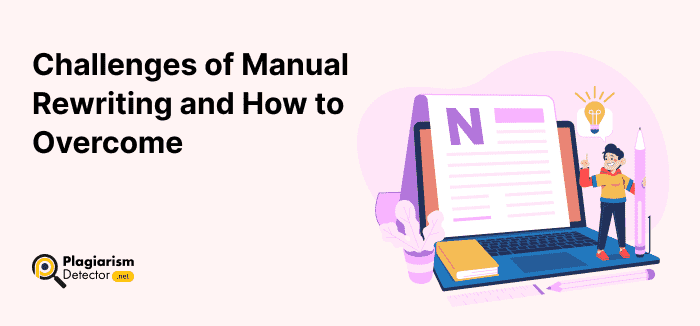Challenges of Manual Rewriting and How to Overcome

Due to the continuously rising need to produce online content, it is essential to infuse creativity. Both businesses and individuals strive to produce unique, engaging, and high-quality content by manual rewriting.
Rewriting presents the same information in different wording. Manual rewriting has been a common method to repurpose existing content while maintaining originality. However, this process can be time-consuming, challenging, and prone to errors. When manually rewriting the content, finding new ways to express the same information becomes difficult.
In this post, we will discuss the common challenges of manual rewriting and explore effective strategies to overcome them.
Challenges of Manual Rewriting
Here are some risks associated with manual rewriting.
Time Consumption
The first challenge that you might face when rewriting manually is time consumption. Extensive rewriting is a tedious task that requires a lot of effort. You must look for the smallest mistakes in the content and correct them individually.
Manual rewriting requires you to go through the article sentence by sentence. This way, it consumes a sheer amount of valuable time and decreases your overall productivity. You can use a paraphrasing detector to rephrase the whole content in a few seconds.
Writer’s Block
Writer’s block is a common challenge faced by those who engage in manual rewriting. It occurs when a writer feels stuck to express the same information freshly and engagingly.
This often happens when the original content is heavily relied upon. Therefore, writers are unable to generate new ideas, which leads to feelings of frustration. Overcoming writer’s block requires flexibility to explore different approaches to the content.
Plagiarism Risk
In manual rewriting, the core challenge is to redraft the content while maintaining originality. Plagiarism is a serious concern in content creation. Manual rewriting can unintentionally lead to plagiarism if not done carefully.
Generating unique perspectives and using proper citations is necessary to mitigate this risk. It’s essential to maintain uniqueness while restructuring content.
Grammar Issues
It is understood that manual writing or rewriting may leave writing errors. Human written content commonly contains grammatical, spelling, or punctuation errors. Moreover, maintaining consistency and coherence while rewriting is a challenge.
Changing the writing style and structure can also ruin the content quality. Such mistakes are easily ignored when updating content manually, which negatively impacts your content strategy.
Strategies to Overcome Manual Rewriting
Manual rewriting is a time-consuming process, but you can use a completely different approach to overcome this challenge. Instead of rewriting the articles entirely by hand, you can adopt the following strategies.
Deep Understanding
First and foremost, develop a deep understanding of the original content. Thoughtfully comprehending the original content resource will help you rewrite it accurately while maintaining quality.
A good approach for rewriting content is to thoroughly analyze the source material and expand your subject knowledge. You can also adopt active learning techniques to identify the meaning and context.
Brainstorming Ideas
After developing a complete understanding of the content, the next step is brainstorming. This technique will help you to generate new ideas and perspectives within the current scenarios.
You can generate a mind map of the content using brainstorming techniques. This way, you can capture the flow of concepts to effectively organize the information and connect related ideas.
Varying Sentence Structure
Changing sentence structure is the most common technique used for rewriting. It presents the same information differently without changing the main concepts. It is an effective yet time-consuming method. Moreover, it can affect the readability of the rewritten content.
To change the sentence structure, you need to go through each section line by line. To overcome this challenge, you can rewrite the whole sentence using the sentence rewriter. It can reword the content effortlessly in a few seconds, saving a lot of valuable time.
Ensure Uniqueness
After rewriting the content, you need to check whether it is unique or not. When you are creating new content with the same ideas, it may lead to unintentional plagiarism. However, maintaining uniqueness in the rewritten content is the main goal.
To detect unintentional plagiarism in rewritten content, use the a free plagiarism checker. It will highlight the plagiarized content in a few seconds. Then, you can simply reword the plagiarized text to give it a unique touch.
Proofreading and Editing
The final step of rewriting is proofreading and editing. Before finalizing the rewritten content, it is essential to identify the grammatical mistakes and writing errors. Such mistakes affect the readability of your content.
Correcting the mistakes will ensure clear and accurate rewriting. For effective rewriting, proofread your content with the grammar checker. It will not only identify mistakes but also suggest corrections. So you can effortlessly proofread and edit the rewritten content.




